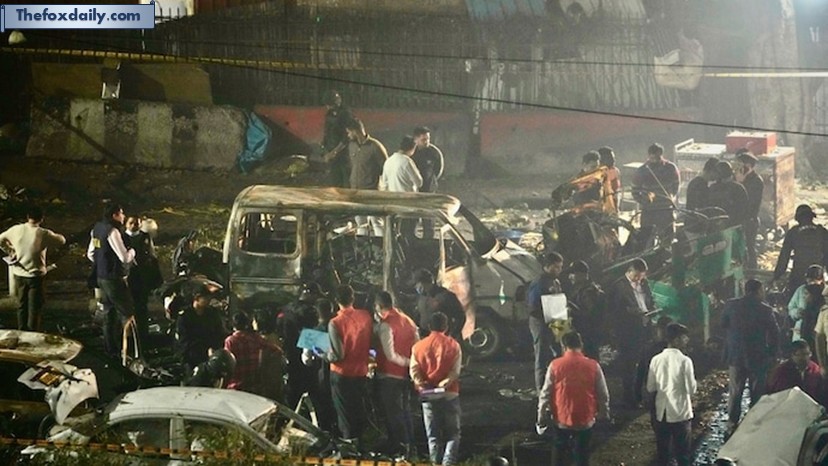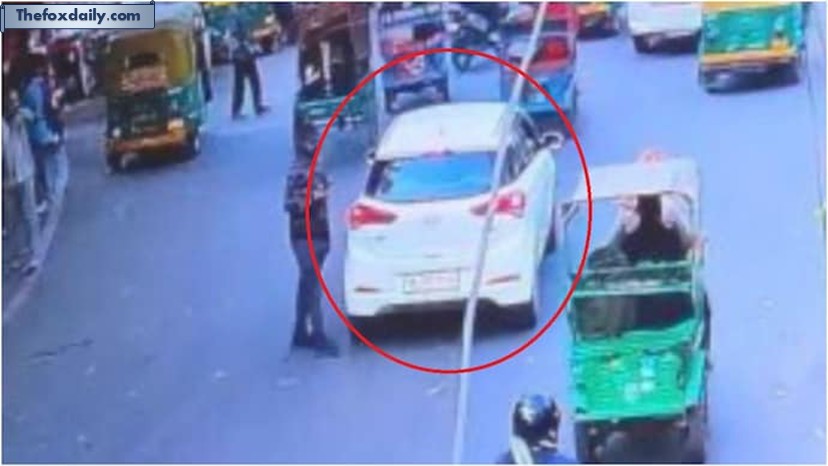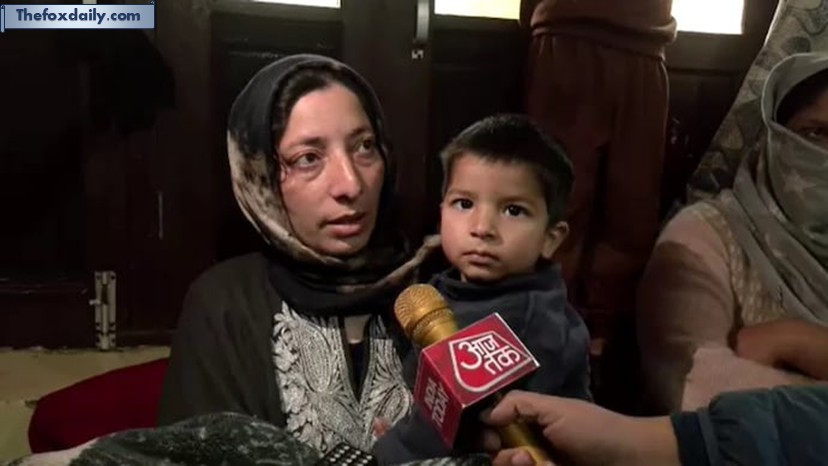
- Explosion Details: What Happened Near Red Fort
- Timeline: The Hyundai i20’s Movements Before the Blast
- Key Developments: Investigation Intensifies
- Security Alert Across Metro Cities
- Chain of Car Ownership Raises Questions
- Dr Umar Mohammad: From Scholar to Suspect
- Possible Motive and Faridabad Connection
- Wider Probe: Kashmir Raids and National Implications
- Red Fort Blast Case: What Lies Ahead
In a shocking incident that rattled the national capital, a massive explosion near Red Fort on Monday evening turned a bustling evening commute into chaos. The blast occurred inside a Hyundai i20 car near Gate No. 1 of Red Fort Metro Station around 6:52 PM, killing nine people and injuring more than 20 others.
Eyewitnesses described the explosion as “earth-shaking,” with flames leaping several feet high. The impact damaged multiple vehicles nearby and caused temporary power cuts as streetlights flickered off. Teams from the National Security Guard (NSG) and forensic units rushed to the scene and collected residue samples to determine the exact cause of the blast.
Explosion Details: What Happened Near Red Fort
According to initial reports, the blast took place inside a Hyundai i20 with a Haryana number plate. The car had three occupants and was idling in evening traffic when it suddenly exploded. Investigators are analyzing whether the explosion was caused by a mechanical malfunction, a chemical reaction, or a targeted explosive device.
Preliminary forensic findings suggest that no shrapnel or metallic fragments—such as nails or ball bearings typically found in Improvised Explosive Devices (IEDs)—were discovered at the site. This points to a chemical or fuel-based explosion rather than a traditional bomb detonation.
Timeline: The Hyundai i20’s Movements Before the Blast

| Time | Event Description |
|---|---|
| 8:04 AM | The car entered Delhi from the Badarpur toll booth, crossing over from Faridabad. |
| 8:20 AM | It stopped briefly at a petrol pump near Okhla Industrial Area. |
| 3:19 PM | The vehicle parked near Sunehri Masjid, adjacent to Red Fort. |
| 6:22 PM | The car exited the same parking area, as shown in CCTV footage. |
| 6:52 PM | The car stopped at a red light near Gate No.1 of Red Fort Metro Station and exploded moments later. |
CCTV footage revealed the car’s prolonged stay near the Sunehri Masjid, suggesting that the suspect may have conducted reconnaissance before the explosion. Footage also captured the driver wearing a black face mask, raising suspicions of deliberate concealment.
Key Developments: Investigation Intensifies
- The car has been traced to Tariq Ahmad Dar from Pulwama, Jammu and Kashmir. However, the vehicle’s registration certificate still bears the name of its previous owner, Md Salman from Haryana.
- Officials confirmed the car had received a traffic challan in Faridabad on September 20, 2025, for illegal parking.
- NSG and forensic teams are analyzing chemical residues to identify whether the explosive used was ammonium nitrate or TNT.
- Union Home Minister Amit Shah confirmed that the NIA, NSG, and Delhi Police are jointly investigating the case.
- Security has been heightened in Delhi, Noida, Mumbai, Hyderabad, and Kolkata, with special focus on airports, metro stations, and government buildings.
Security Alert Across Metro Cities
Following the explosion, the Ministry of Home Affairs placed several Indian cities under high alert. Security checks were intensified at major transport hubs including New Delhi, Old Delhi, Nizamuddin, Anand Vihar, and Ghaziabad railway stations. Dog squads, baggage scanners, and surveillance systems have been activated round the clock.
Prime Minister Narendra Modi expressed condolences to the families of those killed in the blast and wished a speedy recovery to the injured. He also assured that “those responsible will be brought to justice swiftly.”
Chain of Car Ownership Raises Questions
The Hyundai i20 involved in the explosion has revealed a complex chain of ownership. The vehicle was first owned by Md Salman, who sold it to Nadeem. Nadeem handed it to a Faridabad dealer named Royal Car Zone. Later, it was purchased by Aamir, who passed it to Tariq Ahmad Dar of Pulwama. Eventually, the car reached Dr Umar Mohammad — the prime suspect in the case.
Investigators suspect that fraudulent papers and informal deals were used to conceal the vehicle’s real owner. The registration certificate, however, remained unchanged, making it harder to trace direct accountability.
Dr Umar Mohammad: From Scholar to Suspect
Dr Umar, a researcher associated with Faridabad’s Al-Falah University and Hospital, is emerging as a key suspect in the Red Fort blast. His name appeared in connection with a terror module busted by the J&K Police, linked to Jaish-e-Mohammed and Ansar Ghazwat-ul-Hind.
His family in Pulwama, however, expressed disbelief. “He was a kitab ka keeda — a bookworm, always urging us to study,” his sister-in-law told reporters, describing him as “our only hope to rise from poverty.”
Possible Motive and Faridabad Connection
Earlier the same day, Haryana Police recovered 360 kg of ammonium nitrate and another 2,500 kg of explosive chemicals from an apartment in Faridabad. Officials believe this stockpile was part of a larger plan to execute multiple attacks in Delhi.
Investigators suspect Dr Umar may have panicked following the arrest of his associate, Dr Muzammil Shakeel, another Al-Falah University staffer detained during the Faridabad raids. Sources claim the Red Fort explosion might have been a desperate, last-minute act to destroy evidence or trigger diversionary chaos.
Wider Probe: Kashmir Raids and National Implications

Police teams have conducted multiple raids in Shopian and Pulwama, detaining several suspects including Imran alias Maulvi of Nadigam. The probe now spans multiple states as intelligence agencies piece together a possible terror module network connecting Delhi, Haryana, and Jammu & Kashmir.
The blast site near Chandni Chowk remains sealed off for forensic analysis, with experts continuing to test chemical residues, wiring, and heat signatures from the debris.
Red Fort Blast Case: What Lies Ahead
The Red Fort blast has reignited debates over urban security and terror preparedness in India’s major cities. While investigators continue to examine every angle — from mechanical failure to organized terror strike — officials stress that the final forensic report will be crucial in determining the exact nature of the explosion.
As Delhi remains on edge, Home Minister Amit Shah stated that a detailed review meeting with top security officers will be held to evaluate surveillance gaps and ensure coordinated intelligence sharing between agencies.
Conclusion
The explosion near Red Fort has not only claimed lives but also exposed the fragile underbelly of urban security and the dangers of unregistered vehicle transfers. Whether it was an accidental blast or an orchestrated terror strike, the incident underscores the urgent need for improved vigilance, tighter regulation of explosives, and stronger inter-state coordination to prevent such tragedies in the future.
For breaking news and live news updates, like us on Facebook or follow us on Twitter and Instagram. Read more on Latest India on thefoxdaily.com.






COMMENTS 0